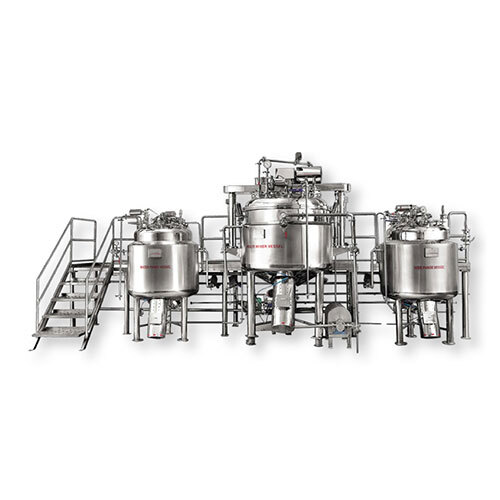Pharmaceutical Liquid Manufacturing Plant
1000000 INR/Unit
Product Details:
- Product Type Ointment Manufacturing Plant
- General Use Industrial
- Material Stainless Steel Alloy
- Computerized No
- Automatic Yes
- Control System Human Machine Interface
- Voltage 415 Volt (v)
- Click to View more
X
Pharmaceutical Ointment Manufacturing Plant Price and Quantity
- 1000000 INR/Unit
- 1 Unit
Pharmaceutical Ointment Manufacturing Plant Specifications
- Human Machine Interface
- Yes
- No
- Industrial
- Stainless Steel Alloy
- 415 Volt (v)
- High Efficiency Simple Control High Performance
- Ointment Manufacturing Plant
- 1 Year
- Gray
Pharmaceutical Liquid Manufacturing Plant Trade Information
- 1 Unit Per Week
- 8 to 10 Week
Product Description
An pharmaceutical ointment manufacturing plant is a facility designed for the production of ointments, which are semi-solid, greasy substances typically used for topical application to the skin or mucous membranes. Ointments are commonly used to deliver medications, provide moisturization, or create a protective barrier on the skin.
The manufacturing process in an pharmaceutical ointment manufacturing plant involves several steps:
1. Formulation Development: Scientists and researchers develop the ointment formula, which includes the active ingredients, excipients (inactive components), and the base that gives the ointment its texture and consistency.
2. Raw Material Procurement: The plant acquires the necessary raw materials, such as active pharmaceutical ingredients, excipients, and packaging materials.
3. Weighing and Mixing: The raw materials are accurately measured and mixed according to the formulation. This step requires precision to ensure the correct ratio of ingredients.
4. Heating and Melting: Some ointment bases are solid at room temperature, so they need to be heated and melted to achieve the desired consistency. Heat-sensitive ingredients are added carefully to prevent degradation.
5. Homogenization: The melted mixture is homogenized to ensure uniform distribution of the active ingredients and excipients. This step is crucial for consistent quality.
6. Cooling and Filling: The homogenized mixture is allowed to cool down and solidify to the desired consistency. Once cooled, it's filled into tubes, jars, or other appropriate containers.
7. Labeling and Packaging: Containers are labeled with necessary information, including product name, instructions, and ingredient list. The containers are then packaged into boxes or cartons for distribution.
8. Quality Control: Throughout the manufacturing process, quality control measures are implemented to ensure that the ointments meet specified standards for potency, uniformity, and safety.
9. Regulatory Compliance: Ointment manufacturing plants must adhere to various regulations and guidelines set by health authorities to ensure the safety and efficacy of the products.
10. Storage and Distribution: The finished ointments are stored in appropriate conditions to maintain their stability. They are then distributed to pharmacies, hospitals, and other healthcare facilities.
FAQ:
1. What is an pharmaceutical ointment manufacturing plant?
Ans: An ointment manufacturing plant is a facility dedicated to the production of ointments, which are semi-solid substances applied topically to the skin or mucous membranes. These plants formulate, process, and package ointments for various medical, cosmetic, and therapeutic purposes.
2. What are the key components of an pharmaceutical ointment manufacturing plant?
Ans: Key components include formulation development labs, raw material storage areas, mixing and processing equipment, filling and packaging stations, quality control labs, and storage facilities for finished products.
3. What are the main steps in the manufacturing process?
Ans: The process typically involves formulation development, raw material procurement, weighing and mixing, heating and melting, homogenization, cooling and filling, labeling and packaging, quality control, and distribution.
4. What are some common types of ointments produced in these plants?
Ans: Ointments can vary widely, from medicated ointments delivering active pharmaceutical ingredients to cosmetic ointments for moisturization. Examples include antibiotic ointments, corticosteroid ointments, and herbal-based ointments.
5. How is quality control ensured in ointment manufacturing?
Ans: Quality control involves testing raw materials, in-process samples, and finished products for potency, uniformity, stability, and safety. This helps ensure that the products meet regulatory standards and provide consistent efficacy.
6. What are the regulatory considerations for ointment manufacturing plants?
Ans: Ointment manufacturing plants must adhere to regulations set by health authorities such as the FDA (U.S.), EMA (EU), and other relevant bodies. Compliance ensures that products are safe, effective, and properly labeled.
7. What equipment is used in pharmaceutical ointment manufacturing?
Ans: Common equipment includes mixing vessels, homogenizers, heating and cooling systems, filling machines, labeling machines, and packaging equipment. All equipment must be designed to meet quality and regulatory standards.
8. How do ointment manufacturing plants handle different types of ointment bases?
Ans: Different ointment bases require varying processing techniques. For example, some bases are heated and melted, while others are kept at a specific temperature range during mixing and processing.
9. What precautions are taken for hygiene and contamination control?
Ans: Hygiene is critical to prevent contamination. Plants implement stringent cleanliness protocols, including gowning procedures, air filtration, and restricted access to certain areas.
10. Can pharmaceutical ointment manufacturing plants customize formulations?
Ans: Yes, many plants have formulation development teams that can customize ointment formulas to meet specific client needs, taking into account active ingredients, excipients, and intended use.
11. Are there sustainability considerations in ointment manufacturing?
Ans: Increasingly, plants are focusing on sustainable practices by reducing energy consumption, optimizing packaging, and using environmentally friendly ingredients.
12. How do pharmaceutical ointment manufacturing plants handle waste disposal?
Ans: Waste disposal follows strict guidelines to ensure proper disposal of waste materials, including chemicals and packaging materials, in an environmentally
responsible manner.
Enter Buying Requirement Details

 English
English Spanish
Spanish French
French German
German Italian
Italian Chinese (Simplified)
Chinese (Simplified) Japanese
Japanese Korean
Korean Arabic
Arabic Portuguese
Portuguese





